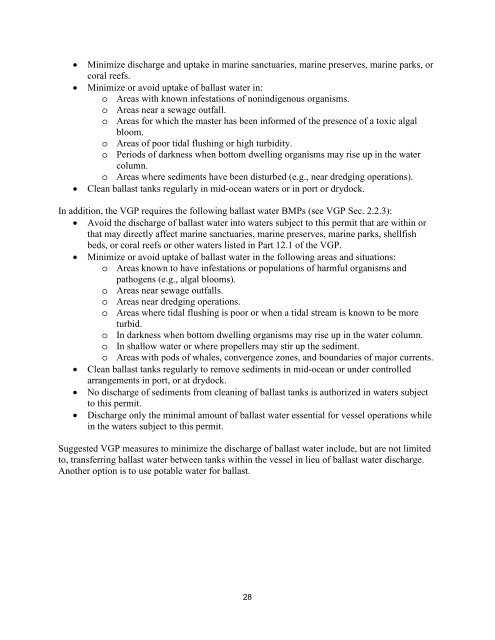Vessel Discharge Rules and Regulations - The Port of Los Angeles
Vessel Discharge Rules and Regulations - The Port of Los Angeles
Vessel Discharge Rules and Regulations - The Port of Los Angeles
Create successful ePaper yourself
Turn your PDF publications into a flip-book with our unique Google optimized e-Paper software.
• Minimize discharge <strong>and</strong> uptake in marine sanctuaries, marine preserves, marine parks, or<br />
coral reefs.<br />
• Minimize or avoid uptake <strong>of</strong> ballast water in:<br />
o Areas with known infestations <strong>of</strong> nonindigenous organisms.<br />
o Areas near a sewage outfall.<br />
o Areas for which the master has been informed <strong>of</strong> the presence <strong>of</strong> a toxic algal<br />
bloom.<br />
o Areas <strong>of</strong> poor tidal flushing or high turbidity.<br />
o Periods <strong>of</strong> darkness when bottom dwelling organisms may rise up in the water<br />
column.<br />
o Areas where sediments have been disturbed (e.g., near dredging operations).<br />
• Clean ballast tanks regularly in mid-ocean waters or in port or drydock.<br />
In addition, the VGP requires the following ballast water BMPs (see VGP Sec. 2.2.3):<br />
• Avoid the discharge <strong>of</strong> ballast water into waters subject to this permit that are within or<br />
that may directly affect marine sanctuaries, marine preserves, marine parks, shellfish<br />
beds, or coral reefs or other waters listed in Part 12.1 <strong>of</strong> the VGP.<br />
• Minimize or avoid uptake <strong>of</strong> ballast water in the following areas <strong>and</strong> situations:<br />
o Areas known to have infestations or populations <strong>of</strong> harmful organisms <strong>and</strong><br />
pathogens (e.g., algal blooms).<br />
o Areas near sewage outfalls.<br />
o Areas near dredging operations.<br />
o Areas where tidal flushing is poor or when a tidal stream is known to be more<br />
turbid.<br />
o In darkness when bottom dwelling organisms may rise up in the water column.<br />
o In shallow water or where propellers may stir up the sediment.<br />
o Areas with pods <strong>of</strong> whales, convergence zones, <strong>and</strong> boundaries <strong>of</strong> major currents.<br />
• Clean ballast tanks regularly to remove sediments in mid-ocean or under controlled<br />
arrangements in port, or at drydock.<br />
• No discharge <strong>of</strong> sediments from cleaning <strong>of</strong> ballast tanks is authorized in waters subject<br />
to this permit.<br />
• <strong>Discharge</strong> only the minimal amount <strong>of</strong> ballast water essential for vessel operations while<br />
in the waters subject to this permit.<br />
Suggested VGP measures to minimize the discharge <strong>of</strong> ballast water include, but are not limited<br />
to, transferring ballast water between tanks within the vessel in lieu <strong>of</strong> ballast water discharge.<br />
Another option is to use potable water for ballast.<br />
28

















